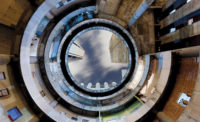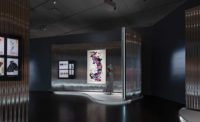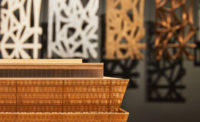Nature has long been a source of inspiration for artists and designers. Think of Hector Guimard’s sinuous Art Nouveau entrance canopies to the Paris Métro, or Frank Lloyd Wright’s organic building forms. A new exhibition at the Denver Art Museum (DAM) aims to go deeper than mere inspiration by exploring what curator Darrin Alfred calls the “transformative role” of contemporary artists, designers, and architects in rekindling our fundamental connection with nature.
Biophilia: Nature Reimagined takes its title from the late American biologist and writer Edward O. Wilson, who defined biophilia as “the innate tendency to focus on life and lifelike processes.” For the exhibition, Alfred, DAM’s curator of architecture and design, assembled more than 80 works—including furniture, physical objects, sculptures, digital installations, architectural models and renderings, clothing, and multisensory experiences—under three themes: “Natural Analogs: Form and Pattern,” “Natural Systems: Processes and Phenomena,” and “Topophilia: People and Place.”

Flowers and People - A Whole Year Per Hour (2020) by teamLab. Photo by James Florio, courtesy the Denver Art Museum
The categories make sense, but they’re hardly necessary to fully experience the exhibition, which fills the meandering galleries of the museum’s second-level exhibition space. Visitors first encounter a large, hand-tufted wool carpet by the Argentine textile artist Alexandra Kehayoglou. The piece, entitled Bajío (Lowland), depicts a small fragment of wetland in Argentina’s Paraná River Delta. A title card explains that “Kehayoglou considers her emphasis on the delta’s complexity and beauty of type of environmental activism.”

Installation image of Biophilia: Nature Reimagined. Photo by James Florio, courtesy the Denver Art Museum
Several pieces in the exhibition seem to have emerged directly from the earth. Three delicate paper baskets, by the late Indigenous artist Terrol Dew Johnson and Aranda\Lasch Studio, celebrate the rugged beauty of the Sonoran Desert. It’s easy to imagine them drifting along with the tumbling tumbleweeds. For Remolten N1 Stools and Table, Santiago-based studio gt2P collected basaltic andesite from Chile’s Osorno volcano and ground the lava-formed rock into powder, which was then applied to the surface of stoneware structures. When fired in a kiln, the powder melts into unexpected shapes and textures.
Other works employ technology to re-create the natural world. Meadow, by Lonneke Gordijn and Ralph Nauta of Amsterdam-based studio DRIFT, is a kinetic installation that features suspended mechanical silk flowers that open and close at different times. Flowers and People—A Whole Year per Hour, a digital installation by the Tokyo-based art collective teamLab, uses six video screens to compress an entire year of flowers blooming into one hour. It’s a mesmerizing display, but it’s also interactive. As you move close to the screens, the flowers grow more profusely. Move away, and the flowers start to wither and die and then blow away. The takeaway: humans are not separate from nature but are an integral part of it.

1

2
One-seater Concrete Tree (2022) by Nacho Carbonell (1) and Meadow (2017) by DRIFT. Photos by James Florio, courtesy the Denver Art Museum
Three architecture firms are featured in the exhibition: Studio Gang, MAD Architects, and J. MAYER H. Conveniently, Studio Gang has designed a new hotel, Populus, currently under construction just a block away from the DAM campus in Denver’s Civic Center. The hotel’s distinctive window shapes were informed by the characteristic patterns found on the trunks of aspen trees. (Founding partner Jeanne Gang got the idea for the facade on a Colorado backpacking trip with her husband.) For Biophilia, Alfred included a large-scale model of Populus along with architectural renderings and drawings.
MAD Architects is also completing a Denver project, One River North, an apartment building with a prominent gash in its facade that will be filled with plants. However, Biophilia puts the spotlight on another project by the Beijing-headquartered firm: the Nanjing Zendai Himalayas Center, a mixed-use complex with mountain-like structures meant to evoke a traditional Chinese landscape painting. It’s no wonder Alfred chose the project for the exhibition. According to the architects, the center’s design “maintains and develops the philosophy of cooperation between humanity and nature, albeit in a modern setting.” The project “seeks to restore harmony between humans and the environment by creating integrated, contemplative spaces that sill meet the material needs of modern life.”

Midnight in the Meadow Wallpaper (2023) by David Wiseman. Photo by James Florio, courtesy the Denver Art Museum

Installation image of Bajo (Lowland) (2024) (on floor) by Alexandra Kehayoglou and Arcadia (2021) (on wall) by Jason DeMarte. Photo by James Florio, courtesy the Denver Art Museum
J. MAYER H.’s mushroom-like Metropol Parasol, a large timber canopy structure in Seville, Spain, is depicted in photographs and an acrylic model.
The curvy architecture of the late Zaha Hadid would have fit perfectly in the exhibition, but Alfred instead chose to feature six pleated marble vases designed by the architect and manufactured by the Italian firm Citco.
In his introduction to the show’s digital catalog, Alfred calls Biophilia “a call to action, urging us to embark on a journey of reconnection with nature.” It’s a lofty goal that may strike a chord with some visitors, but others will be satisfied to immerse themselves in the delightfully eclectic works Alfred has brought together.
Biophilia: Nature Reimagined is on view at the Denver Art Museum through August. 11, 2024.





Post a comment to this article
Report Abusive Comment